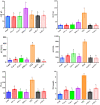Postbiotic Gamma-Aminobutyric Acid and Camel Milk Intervention as Innovative Trends Against Hyperglycemia and Hyperlipidemia in Streptozotocin-Induced C57BL/6J Diabetic Mice
- PMID: 35898909
- PMCID: PMC9313471
- DOI: 10.3389/fmicb.2022.943930
Postbiotic Gamma-Aminobutyric Acid and Camel Milk Intervention as Innovative Trends Against Hyperglycemia and Hyperlipidemia in Streptozotocin-Induced C57BL/6J Diabetic Mice
Abstract
Diabetes is a serious disease that threatens human health worldwide. The study hypothesis is to investigate the novel trends that may aid in the prevention of diabetic complications. Camel milk was presented as traditional functional food, and Lactobacillus brevis KLDS1.0727 and KLDS1.0373 strains were shown to synthesize postbiotic Gamma-aminobutyric acid as a potential food additive, which can therapeutically intervene against hyperglycemia and hyperlipidemia in streptozotocin-induced C57BL/6J mice. During a four-week timeframe, body weight and postprandial blood glucose levels were monitored. Post-euthanasia, blood plasma was obtained to investigate hyperlipidemia, insulin concentrations, liver, and renal functions. The liver, pancreas, kidney, and spleen underwent histopathological examinations. The results demonstrated that KLDS1.0727 and KLDS1.0373 (LACS1 , LACS2 ) and camel milk treatments all had a significant influence on hypoglycemic activity, as evidenced by reduced postprandial blood glucose levels. LACS1 , LACS2 , and camel milk therapy significantly reduced blood hypolipidemic, and some liver enzymes such as (alanine aminotransferase and aspartate transaminase) levels. Therefore, we recommend consuming camel milk regularly and expanding its use with fermented foods containing L. brevis, one of the probiotics capable of producing gamma-aminobutyric acid (GABA) as future food additives that can improve human health and reduce the prevalence of several diseases disorders.
Keywords: C57BL/6 mice; Lactobacillus brevis; camel milk; diabetes type 1; gamma-aminobutyric acid; postbiotic.
Copyright © 2022 Abdelazez, Alshehry, Algarni, Al Jumayi, Abdel-Motaal and Meng.
Conflict of interest statement
The authors declare that the research was conducted in the absence of any commercial or financial relationships that could be construed as a potential conflict of interest.
Figures







Similar articles
-
Effect of camel milk protein hydrolysates against hyperglycemia, hyperlipidemia, and associated oxidative stress in streptozotocin (STZ)-induced diabetic rats.J Dairy Sci. 2021 Feb;104(2):1304-1317. doi: 10.3168/jds.2020-19412. Epub 2020 Nov 30. J Dairy Sci. 2021. PMID: 33272578
-
Comparison of the hypoglycemic and antithrombotic (anticoagulant) actions of whole bovine and camel milk in streptozotocin-induced diabetes mellitus in rats.J Dairy Sci. 2020 Jan;103(1):30-41. doi: 10.3168/jds.2019-16606. Epub 2019 Oct 16. J Dairy Sci. 2020. PMID: 31629513
-
Lactobacillus acidophilus alleviates type 2 diabetes by regulating hepatic glucose, lipid metabolism and gut microbiota in mice.Food Funct. 2019 Sep 1;10(9):5804-5815. doi: 10.1039/c9fo01062a. Epub 2019 Aug 28. Food Funct. 2019. PMID: 31461095
-
Camel milk: a possible boon for type 1 diabetic patients.Cell Mol Biol (Noisy-le-grand). 2013 Nov 3;59(1):99-107. Cell Mol Biol (Noisy-le-grand). 2013. PMID: 24200025 Review.
-
Camel milk protectiveness toward multiple liver disorders: A review.Front Nutr. 2022 Sep 15;9:944842. doi: 10.3389/fnut.2022.944842. eCollection 2022. Front Nutr. 2022. PMID: 36185679 Free PMC article. Review.
Cited by
-
Postbiotics: an insightful review of the latest category in functional biotics.World J Microbiol Biotechnol. 2025 Aug 2;41(8):293. doi: 10.1007/s11274-025-04483-8. World J Microbiol Biotechnol. 2025. PMID: 40751848 Free PMC article. Review.
-
Role of γ-Aminobutyric Acid (GABA) as an Inhibitory Neurotransmitter in Diabetes Management: Mechanisms and Therapeutic Implications.Biomolecules. 2025 Mar 11;15(3):399. doi: 10.3390/biom15030399. Biomolecules. 2025. PMID: 40149935 Free PMC article. Review.
-
Gut-Liver-Pancreas Axis Crosstalk in Health and Disease: From the Role of Microbial Metabolites to Innovative Microbiota Manipulating Strategies.Biomedicines. 2024 Jun 24;12(7):1398. doi: 10.3390/biomedicines12071398. Biomedicines. 2024. PMID: 39061972 Free PMC article. Review.
-
Creation and gene expression analysis of a giant embryo rice mutant with high GABA content.Mol Breed. 2023 Jan 11;43(1):3. doi: 10.1007/s11032-022-01353-1. eCollection 2023 Jan. Mol Breed. 2023. PMID: 37312870 Free PMC article.
-
Renal Health Improvement in Diabetes through Microbiome Modulation of the Gut-Kidney Axis with Biotics: A Systematic and Narrative Review of Randomized Controlled Trials.Int J Mol Sci. 2022 Nov 27;23(23):14838. doi: 10.3390/ijms232314838. Int J Mol Sci. 2022. PMID: 36499168 Free PMC article. Review.
References
-
- Abdelazez A., Abdelmotaal H., Evivie S. E., Bikheet M., Sami R., Mohamed H., et al. . (2022). Verification of Lactobacillus brevis tolerance to simulated gastric juice and the potential effects of postbiotic gamma-aminobutyric acid in streptozotocin-induced diabetic mice. Food Sci. Hum. Wellness 11, 165–176. doi: 10.1016/j.fshw.2021.07.017 - DOI
-
- Abdelazez A., Abdelmotaal H., Evivie S. E., Melak S., Jia F. F., Khoso M. H., et al. . (2018). Screening potential probiotic characteristics of Lactobacillus brevis strains in vitro and intervention effect on type I diabetes in vivo. Biomed. Res. Int. 2018:7356173. doi: 10.1155/2018/7356173, PMID: - DOI - PMC - PubMed
-
- Abdulrahman A. O., Ismael M. A., Al-Hosaini K., Rame C., Al-Senaidy A. M., Dupont J., et al. . (2016). Differential effects of camel milk on insulin receptor signaling–toward understanding the insulin-like properties of camel milk. Front. Endocrinol. 7:4. doi: 10.3389/fendo.2016.00004, PMID: - DOI - PMC - PubMed
-
- Aguilar-Toalá J. E., Garcia-Varela R., Garcia H. S., Mata-Haro V., González-Córdova A. F., Vallejo-Cordoba B., et al. . (2018). Postbiotics: an evolving term within the functional foods field. Trends Food Sci. Technol. 75, 105–114. doi: 10.1016/j.tifs.2018.03.009 - DOI
LinkOut - more resources
Full Text Sources
Miscellaneous

